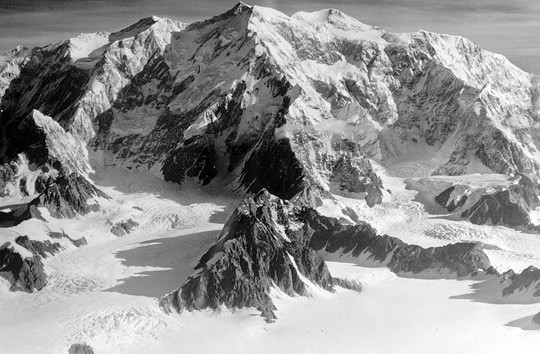
Mt. Logan has seen many climbers journal over the past 85 years. First ascents, new routes, weather conditions and Logan’s overpowering geography have been just some of the subjects of mountaineers’ scribbling. [Photo] AGS, courtesy Allen Steck collection
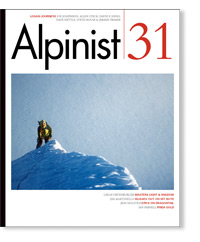
Editor’s Note: Alpinist 31 has been sent off to the printer and will be shipped to subscribers and retail stores soon. In this issue, Joe Josephson takes us through the history of “the mightiest hump in Nature,” Mt. Logan, and delves into the stories from alpinists who have ventured to climb one of its 37 routes or variations.
This online exclusive provides a different perspective on Logan, this time through the expedition diaries of climbers, who have disclosed to Alpinist not only some of what these journals include, but also the reasons why they write in the first place. Pick up a copy of Issue 31 or subscribe to Alpinist for the full Mountain Profile on Mt. Logan.
Labored steps lead you back to the tent. You robotically open the zipper, squeeze your way in and collapse. A long day and a failed summit attempt have left you exhausted and defeated. Lying there, eyes closed, your thoughts speed from the events of the day to your need for sleep. You wish the stove would light itself and boil water for you.
Something else occurs to you. Something perhaps more important than sating your thirst or drifting off to a restless sleep. Rising slowly to your elbows, you reach for your journal and pen and start scribbling.
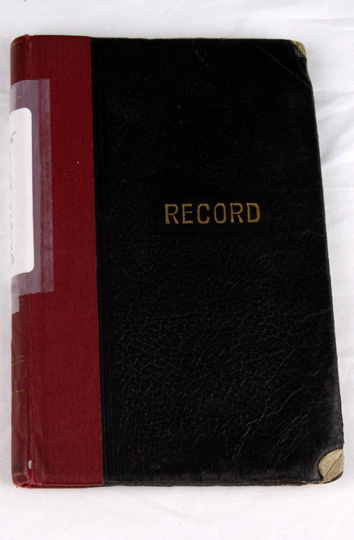
The front cover of John Evans’ journal from his 1965 expedition to Mt. Logan’s Hummingbird Ridge. Mountaineers from every generation of climbing have written about their expeditions and experiences, leaving behind a rich collection of trip reports that in some form have contributed to the documentation of climbing history and the contents of expedition-based books and articles. [Photo] John Evans
Expedition Journaling, A Tradition
To process such intense human experiences, mountaineers from every era and every corner of the world have put their observations onto paper. But as common as expedition journaling may be, there are as many reasons for writing as there are climbers who write; motivation and experience span a broad spectrum.
Mt. Logan (5959m) is the highest mountain in Canada and, by some measures, the largest peak in the world. In researching Logan for Alpinist 31’s Mountain Profile, the author and editors stumbled across an unusual number of expedition journals. Some were very old. A.H. MacCarthy, leader of the 1925 first ascent expedition, inserted a number of direct quotations from his journals into his detailed trip report for the Canadian Alpine Journal (CAJ) that same year. More climbers, of course, followed in MacCarthy’s footsteps, and many of their experiences have been recorded on paper.
To investigate the tradition of expedition journaling, Alpinist interviewed four climbers who kept logs on Mt. Logan. They are John Evans, who climbed the first ascent of the famed Hummingbird Ridge in 1965; David Jones, who, in addition to four other ascents of Logan, established Warbler Ridge–the first route up the south face–in 1977; Jock Glidden, who climbed the second ascent of Logan’s Catenary Ridge in 1979; and Steve House, who climbed a new route on King Peak in 1998.
Less Than Ideal Conditions
Naturally, every climber will take a different approach to journaling while also sharing the common experience of writing while on a mountain. One shared experience that no climber quickly forgets is writing in very poor conditions; wind, cold and snow are not easily escaped when holed up on the side of a peak.

A.H. MacCarthy, leader of the 1925 expedition that put the first ascent up Mt. Logan, kept a journal while on expedition that later assisted him in writing extensive trip reports. [Photo] 1925 Canadian Alpine Journal, courtesy The Alpine Club of Canada
“I actually wrote a lot of stuff, and a lot of it I wrote at the end of long brutal days with frozen fingers,” John Evans described. “I am kind of astonished because I know what a pain it is to take your hands out of your sleeping bag and write.”
“I often run out of energy for writing before I run out of stories,” Steve House said. “I just fatigue, certain parts of the stories doomed to my cramping hand and a body uncomfortable with sitting on the ground.”
And MacCarthy’s article “The Climb” in the 1925 CAJ goes a step further to illustrate just what a luxury writing can be. In the days after descending from his summit push, he wrote in his journal that his expedition mate, Foster, was “busy treating and bandaging frozen fingers and toes, all first joints on my fingers and thumbs frostbitten and turning black.”
Clinging to a pencil with frostbitten fingers, no doubt, provided less than ideal conditions for penning. So why go through the painstaking routine of journaling at all?
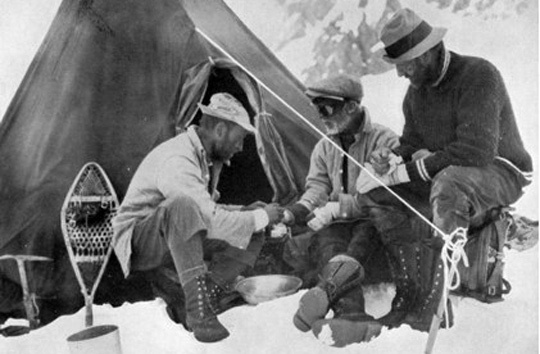
Colonel Foster treats the frostbitten fingers and toes of A.H. MacCarthy and H.F. Lambart after their summit push. Frostbitten fingers make for very poor writing conditions. [Photo] 1925 Canadian Alpine Journal, courtesy The Alpine Club of Canada
Documenting the Facts
The answers our climbers gave to the question of “why” landed in one of two broad camps: journaling to document facts or journaling to process the experience in a personal way.
Much of what we know about each of the climbs on Mt. Logan comes from information originally recorded as a journal entry. Sometimes these entries became references for more detailed depictions in other publications. As John Evans put it, “the journals can contribute to telling the story later.”
David Jones distinguishes his more fact-based journals from more reflective journaling by calling them logs, which he kept for some 45 years. “With few exceptions, my [logs] are focused on [recording] the facts, events, times, elevations, food, fuel consumed – in short information that I might use at some future date,” Jones explained. His logs are extensive and keep a record of every climb he has made, including 250 first ascents and over 600 total routes, he said.
Jock Glidden operates similarly to Jones. Glidden said he often used a notebook to keep track of information, such as expenses, critical addresses and phone numbers, equipment, food lists and medical kit contents.
For Evans, his journals really just serve the purpose of keeping a record of the facts. “In most of my journals, they are not full of great, brilliant insights,” he said. “Mostly it is the day-to-day doing, but nothing very inspirational.” House, on the other hand, doesn’t write for the purpose of details, but rather to reflect on his own thoughts and experiences.
A Friend on the Mountain
House observed: “I think many of us feel a universally human need to download and share our experiences.” His journals may include some facts and figures to remember later, but for the most part they serve to “organize and process the daily internal dialogue.” While climbing partners can help us to “download” our thoughts and feelings, he said, there are times when nothing is more comforting than pen and paper.
He noted that his densest journals are the ones he wrote when on solo expeditions:
“When traveling and climbing with great mates, that naturally happens back at camp, or even in the bivy; that fresh, excited recounting of the day’s special moments, often characterized by overloud voices, hand gestures and amazed laughter at what we got ourselves into–and out of. Those conversations are so charged, so immediate, and so intimate, that I feel like I’m truly re-living the moment. Some of those moments are steeped in ecstasy, some in pain. But they’re so vivid right then.
“When I’m alone, I don’t have that outlet. There is no one to tell the stories to. But the energy is the same. The feeling at these times is that I just can’t write fast enough. On some expeditions I tried taking a miniature voice recorder and speaking into it. (That didn’t work for some reason; I was held back by some self-consciousness.) So, I journal, scribing those raw, immediate emotional memories onto paper.”
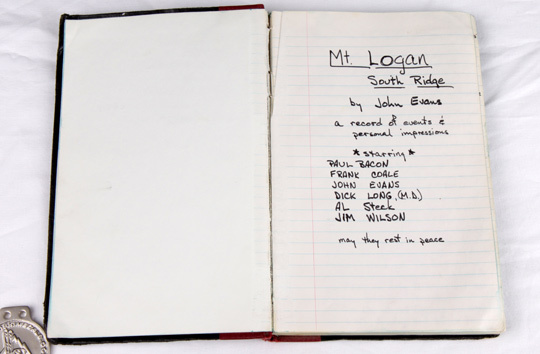
In the front flap of John Evans’ journal from the 1965 Hummingbird Ridge expedition, which he called “a record of events and personal impressions,” he listed the names of his expedition mates. [Photo] John Evans
House forgot to bring his journal to Logan. But that didn’t stop him from writing. He scribbled five or six entries on scrap paper instead. The entries primarily recorded the angst he and Joe Josephson went through deciding when to make their attempt on King Peak. “Sometimes, when the conversations are good, I journal less,” he said, alluding to the fact that, for the most part, his company provided the outlet he needed on that particular ascent.
A journal, then, can be a confidant, listener and a friend who comforts. Jock Glidden, who is also a professional philosopher and, in his words, “trained to be reflective,” found his journal to be “a reflective instrument” that allowed him to consolidate his thoughts. Journaling helped him to prepare for the future, which was the case on Logan when his co-leader, Frank Sarnquist, injured his back early on in the expedition, leaving the burden of leadership solely to Glidden. The important lessons he learned began to congeal as he spent the time to write.
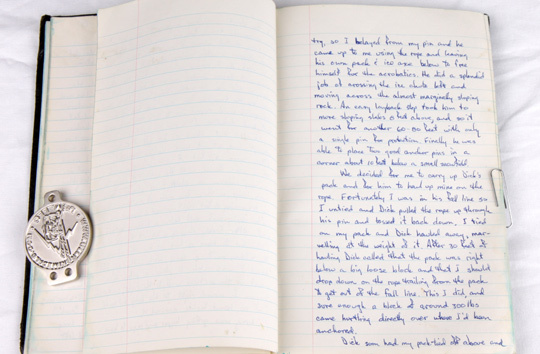
One of the interior pages of John Evans’ journal from Hummingbird Ridge. In it, he wrote, “We decided for me to carry up Dick’s pack and for him to haul up mine on the rope…. After 30 feet of hauling, Dick called that the pack was right below a big loose block and that I should drop down on the rope trailing from the pack to get out of the fall line. This I did, and sure enough a block of around 300 lbs. came hurtling directly over where I’d been anchored.” [Photo] John Evans
To Share or Not to Share?
Whether a climber is writing simply to document facts and memories or unload emotional angst after the necessity for stoicism is over, there remains a question of how and when this content is shared. If climbers like Glidden are learning important lessons–lessons worthy of a journal entry–might they not have something important for others to learn as well?
Ultimately, we know what we know about expeditions to Mt. Logan, and other mountains, because of what climbers have shared publicly. But where do their journals fit in?
The climbers’ responded to this question with a broad spectrum of emphatic personal thoughts. Evans actually sent Alpinist his 1965 Hummingbird Ridge journal in its entirety to use for the Mountain Profile. He also brought this journal to a reunion with his mates from the Hummingbird Ridge expedition and shared it with them.
House, on the other hand, doesn’t see his journals as for anyone but himself. “I’m the only person who has ever read my journals,” he said, “and I expect that I will be the only one to ever read my journals.” House goes as far as to say that he may burn them all before he dies.
As we know, Evans, who handed over his journal to Alpinist, keeps journals that are mostly documentation of hard facts and do not include much information of a personal nature. House is the exact opposite, rarely writing about the day-to-day, instead choosing to explore his thoughts.
Glidden, who falls somewhere in between on the spectrum, commented on how, while his journals are for himself only, he would sometimes read the day’s events to climbing mates “if it wasn’t too personal about them.” What we find here, then, is that factual information is often easier to share than personal introspection.
Even though journal contents may be deeply private, a few climbers revealed that the lessons and stories within them are still widely shared. Both House and Glidden said that they would often use material from their journals when writing for other publications. The same can be said for countless other climbers. Many lean on the writing they did while on expedition to help them remember details when detailing more thorough accounts, whether for articles or books. We have a good example in A.H. MacCarthy, who was able to provide as elaborate an account of the Logan expedition as he did because of the time he spent journaling on the mountain.
Jones pointed out that sharing climbing stories also leads to another valuable outcome. He said that telling stories is a means of communicating limits, like a difficult grade or embarking on a first ascent, and how to persevere. “We are all capable of doing and experiencing vastly more than most people will ever experience,” he explained. “It was not that long ago when ‘5.9’ was the ultimate in technical rock climbing difficulty and there was great reticence to step out from this artificial limitation.”
Remembering, Reliving and Forgetting
When a journal isn’t playing storyteller, what is it doing? Down the road, what purpose do the journals serve for their authors?
All four climbers have used their journals to recall specific details. “Naturally, we forget a lot of our past, the good and the bad parts,” Glidden said. Evans said that he has used them if he was “doing a reprieve or a repeat,” in which case he would share his journals with the rest of the people planning the trip. House also uses them to keep his facts straight. “At times I need to know how long it took us to get to do something, such as climb to the top of the southwest face of King Peak,” he recalled. “I just don’t keep all those times and factoids in my head.” And Jones found his early records of new routes or first ascents to be very helpful when it came time to write his two Selkirks-based mountaineering guidebooks.
Having a way to remember the facts is important to everyone who journals, even those who write for purely personal reasons. “The journals, as original sources, are the ultimate resources for that kind of information,” House said. He explained that his journals allow his to step back in time. “What I like about re-reading my journals isn’t the subjects I chose–it’s the ability they have to transport me back to that person I was at the time I wrote the entry,” he said. “I can read the entries from when I was 25 and be that 25-year-old again; slipping right into it like a worn pair of socks.”
Glidden said that the entries he wrote at age 47 revealed that he identified a lot with Ernest Shackleton, the famed Antarctic explorer. But that is not who he would identify with now at age 74. “What youthful energy I had then,” he remarked. Climbers like House and Glidden, who kept a more personal account of their thoughts and feelings while on an expedition, have gained incredible insight about their former selves through their journals.
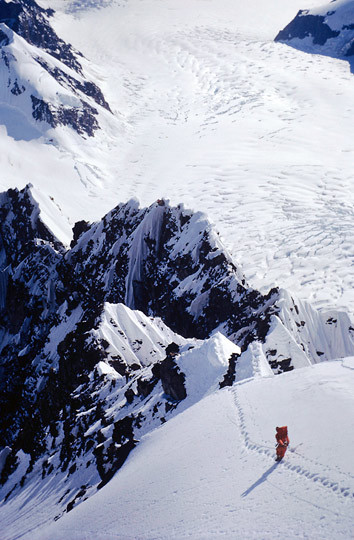
A climber looks down towards the tents at Camp 2 from somewhere above Camp 3 on the 1965 Hummingbird Ridge climb, one of the many expeditions to be documented in journals. [Photo] Allen Steck
But mountaineering expeditions involve as many stories of pain and tragedy as joyful accounts of success and satisfaction. And sometimes the memories are just too painful. For House, “Reliving [the painful memories] through the pen opens partially healed psychic wounds of hard climbing.” Sometimes, writing about the events even long after they have occurred has the same effect. A recent fall and rescue off Mt. Temple in the Canadian Rockies left House with a collapsed right lung, six broken ribs, a fractured pelvis and seven smaller fractures in his spine. House explained that six weeks went by before he wrote more than a paragraph.
In re-reading his Hummingbird Journal before sending it to Alpinist, Evans mentioned he was surprised by how many scary encounters he had written about. “I wrote several times about small falls, missteps and scary stuff, and I don’t remember that being such a great part of the trip,” he said. Whether on purpose or not, he had forgotten about the more troublesome details from his climb up Mt. Logan.
“Forgetting is an important attribute of a good alpinist,” House said. An alpinist may not otherwise climb again if he had to relive the scariest and most painful moments in his climbing career.
Accuracy at Altitude
Remembering may be as important as forgetting for some climbers. Whether they like it or not, and whether or not the physical journal is read by others, the scribbling that occurs on the mountainside often enters into the pool of public knowledge and the documentation of climbing history.
Considering the conditions–mental, physical and emotional–in which these climbers were writing, an interesting question arises: Can we really trust the fuzzy brain of an alpinist writing after a long day out in the elements?
As MacCarthy reflects upon his descent from Logan in his submission to the CAJ:
“Thus, at midnight of June 28th, we again were down to the level where men think and breathe and work in a rational way and so may be held accountable for their actions. If sometimes while above that level, I was harsh and disagreeable, I ask that my companions please forgive me.”
Would the altitude not have affected his writing also? How do you keep the facts straight when you can’t even keep your eyes open? Do frostbitten fingers muddy recollection?
Glidden also observed that “rare is there an expedition that is without error, misgivings, accident or imperfection of some kind.” Glidden reflected on his second ascent of the Catenary Ridge on Logan, a claim he felt is “slightly fraudulent” due to the fact that another party, though unsuccessful with their summit bid, had left behind tent platforms, assisting Glidden’s crew in gaining the summit. “A careful and honest reading of a faithful journal should divulge at least some of [these imperfections],” Glidden remarked.
The blurred memories, difficult conditions and less glamorous occurrences during expeditions become a part of the story itself so long as the writer admits to them. It is only the perspective of an individual climber, who like any writer in history, is prone to bias and his particular view. But, sometimes the documentation in these journals is the only clue to the truth. It is the only story we know. At times it leads to clarity. At other times, controversy.
For the most part, it is the best explanation of why an expedition succeeded or failed, Glidden said.
And this is what makes these journals and climbers so unique. Each journal, and each entry, tells a story, even if it is only the author who reads it. Even then, the author may discover a person from the past, like Steve House or Jock Glidden encountering their youthful selves who were, at one time, immortalized in ink.
Learn more about the history of Mt. Logan in Alpinist 31. Subscribe to Alpinist.